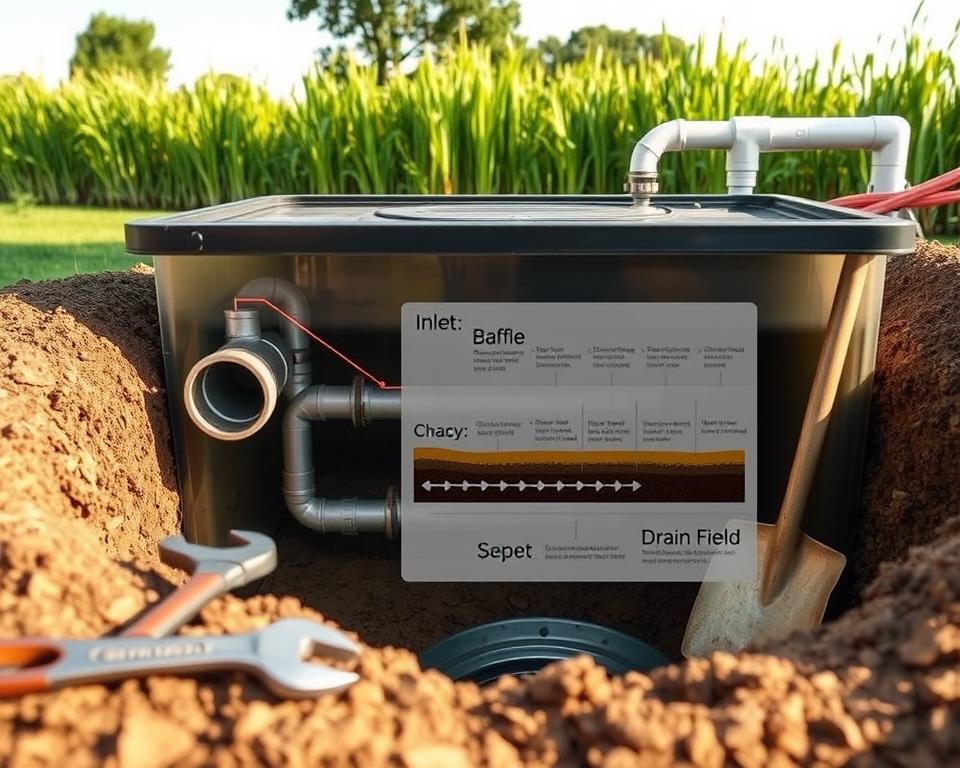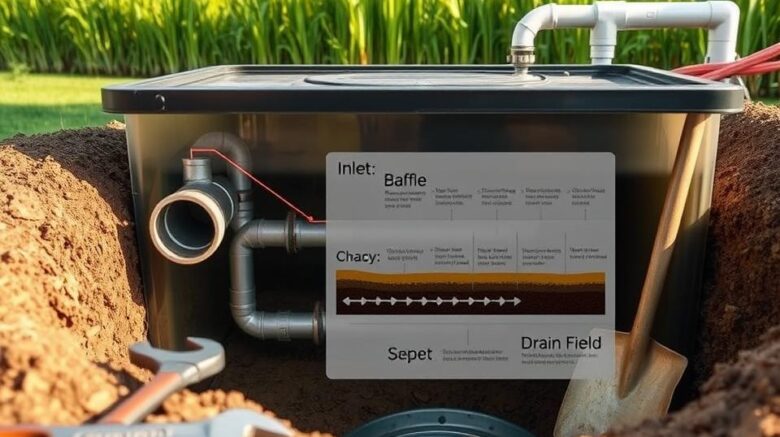Septic Air Pump: Comprehensive Guide for Residential Users
Do you sometimes think about what powers your aerobic Septic setup’s performance? The aeration device is the often-overlooked workhorse indispensable for your system. Throughout this overview, readers will obtain valuable insight on the aerator’s role. It’s necessary for a sound, well-run Septic tank.
Appreciating the importance of a Septic tank air Pump can enhance your Septic system’s functionality using septic pumping service. It also preserves your home equity and ecological well-being. The following guide will highlight All in Sanitation, a reputable Septic industry authority. They’re eager to meet your Septic aerator Pump needs.
Key Insights
- The Septic air Pump is crucial for aerobic Septic systems.
- Looking after your Septic system air Pump can boost overall system efficiency.
- Periodic reviews increase the lifespan of your Septic tank air Pump.
- Choosing the correct Septic aerator Pump is key for optimal operation.
- All in Sanitation supplies specialized services for Septic air Pump needs.
Breaking Down Aerobic Septic Solutions
Aerobic Septic systems provide a superior waste treatment alternative by utilizing oxygen. This system features aerobic bacteria thriving in well-oxygenated environments. These bacteria are better in digesting organic matter. With the help of Septic aerator Pumps, these systems maintain a steady oxygen supply, boosting the waste decomposition process.
These systems shine in lowering sludge buildup, because of the hard work of aerobic bacteria. This cut in solid waste means fewer service calls and periodic Pump service is required. Additionally, they successfully handle wastewater, resulting in minimal smells. This creates a improved environment for homeowners and the community as a whole.
To make sure these systems run smoothly, it’s important to recognize the key Septic system components. These include the Septic tank, aeration chamber, and effluent Pump. Each part has a crucial role, especially the air Pump. It drives oxygen into the tank, central for the aerobic bacteria’s performance.
Role of the Septic Air Pump
The Septic air Pump is key in the running of aerobic Septic systems. It serves as the system’s “breathing mechanism,” supplying the necessary oxygen mandatory. This oxygen enables aerobic bacteria to operate efficiently and decompose waste effectively. If the Pump stops, the system’s effectiveness decreases, resulting in sludge increase and possible odors.
Such issues can hamper Septic system operations and cause environmental hazards. By recognizing how vital the Septic air Pump is, homeowners can respond ahead of time. They can ensure its top function through routine care. This prevents failures, avoids costly repairs, and protects the aerobic system’s condition.
Major Benefits of Using a Septic Air Pump
Operating a Septic air Pump significantly boosts the performance of Septic systems. Septic air Pumps are crucial as they quicken the breakdown of waste. This is realized by oxygenating the treatment process, promoting aerobic bacteria growth. These bacteria are vital for successful waste treatment.
They’re also instrumental in reducing foul smells. Thanks to more active aerobic processes, waste breaks down faster, thus cutting down odors. This ensures better surroundings for homeowners.
Another noteworthy benefit is the reduction in sludge buildup. Consequently, tanks necessitate less frequent Pumping, saving both money and time. Improved processing not only lowers bills but also lengthens the lifespan of the drain field.
Servicing these Pumps well means less frequent repair costs and adhering to regulatory standards. Thus, the benefits of Septic air Pumps aren’t just for homeowners. They also support environmental health by advancing waste management practices.
| Benefit | Description |
|---|---|
| Fast Waste Breakdown | Heightened aerobic activity hastens the decomposition process. |
| Minimized Odor Emissions | Optimized treatment efficacy leads to fewer odors. |
| Reduced Sludge Buildup | Less frequent Pumping and maintenance are needed. |
| Extended Drain Field Life | Better treatment equals a healthier drain field. |
| Cost Savings | Lower risk of repairs and regulatory compliance cost. |

Selecting the Best Septic Air Pump
Selecting the best Septic air Pump is key for an optimized aerobic system. Homeowners need to evaluate various factors for the proper choice. The volume of the tank and the airflow needs play a crucial role the Pump’s efficiency.
To decide wisely, it’s important to know the air Pumps available. There are mainly two types: diaphragm Pumps and rotary vane Pumps. Each offers particular pluses, which should be suited with your home’s specific needs and operational profile.
Electric efficiency also matters. Selecting a Pump that minimizes energy use while delivering the needed airflow can offer significant savings. Guidance from All in Sanitation experts can be very helpful. They help ensure the Pump you choose meets your system’s requirements seamlessly.
Common Types of Septic Air Pumps
Homeowners can choose intelligently by understanding the distinct Septic air Pumps available. There are mainly two types: diaphragm Pumps and rotary vane Pumps. Each has its unique functions and benefits.
Diaphragm Pumps, valued for their low-noise operation, are preferred for residential Septic systems. They deliver energy efficiency while supplying consistent airflow. Their trustworthy performance fits smaller systems, attracting many homeowners.
Rotary vane Pumps, however, are designed for extended or commercial systems. These Pumps produce higher capacity, needed for handling bigger loads. Their strong build delivers efficient operation in extensive Septic systems.
| Type of Pump | Best Use | Advantages |
|---|---|---|
| Diaphragm Pumps | Residential Systems | Quiet operation, energy-efficient, reliable air flow |
| Rotary Vane Pumps | Larger or Commercial Systems | Powerful performance, high capacity, durable construction |
Understanding the contrasts in Septic air Pumps is essential for upgrades or replacements. Each Pump type provides specific features to satisfy various needs. This guarantees peak performance for any system.
Indicators You Require a Septic Air Pump Replacement
Homeowners must look out for Pump failure signs in their Septic systems. Some symptoms suggest the need for a Septic air Pump replacement. These ensure continued performance. Spotting these early prevents bigger issues.
Signs of potential problems include:
- Unusual noises from the Pump, like grinding or vibrating, might mean internal damage.
- A clear lack of air output reveals the Pump isn’t performing as intended, harming efficiency.
- Repeated electrical problems, such as circuit trips or flickering lights, could show overloading.
- Visible damage on the Pump unit, with cracks or leaks, calls for quick action.
- Unpleasant odors in the yard often signal a compromised Pump, meaning ineffective effluent aeration.
Recognizing these signs early prevents expensive repairs or total system failure. Performing consistent assessments helps identify these issues. It also demonstrates if you ought to have a new Septic air Pump.
Service Tips for Your Septic Air Pump
For an efficient Septic air Pump, periodic care is crucial. This guarantees that your system runs well. Homeowners can follow several easy-to-follow care strategies for best results.
Bi-annually, carry out a thorough inspection for wear or damage. It is also important to renew the filters as indicated. This stops clogs that could reduce efficiency.
The Pump should sit on a stable base to lessen vibrations, which could damage it over time. A protective cover is important too. It protects against debris and water, maintaining the Pump’s functionality.
Diligent care can considerably lengthen the life of your Pump. In turn, this supports the Septic system’s performance in general.
| Maintenance Task | Frequency | Benefits |
|---|---|---|
| Inspect Pump for damage | Every 6 months | Identifies issues early |
| Replace filters | As needed | Maintains airflow |
| Check surface stability | Annually | Limits wear |
| Clear debris around Pump | Monthly | Prevents clogs |
Installing Your Septic Air Pump
Correct installation of your Septic air Pump is critical for its optimal operation. Initially, choose a reliable, moisture-free area for placement. The chosen spot should securely accommodate the Pump’s weight without issue.
To effectively install your Pump on your own, follow the following guidelines:
- Collect all necessary items, including the Pump, a power source, and hose fittings.
- Carefully read the manufacturer’s guidelines before starting your installation.
- Make sure every connection is sealed to avoid air leaks that impact performance.
- After assembly, complete a test to check the system works as intended.
If the installation process looks challenging, contact All in Sanitation. Their professionals can prevent common errors, ensuring your setup adheres to mandatory safety requirements.
Why Choose All in Sanitation for Your Septic Air Pump Requirements
When choosing a Septic service provider, the choice is significant. All in Sanitation sets itself by supplying dependable Septic air Pumps. They cater to diverse homeowner requirements with a broad selection of top-tier products. This means customers discover an exact match for their Septic systems.
What further defines All in Sanitation is in addition to their extensive product lineup. Their focus to exceptional customer service is also critical. Homeowners get professional guidance, guiding them towards trusted Septic solutions. This joint effort is essential to tailor each solution to meet specific needs.
All in Sanitation also prioritizes aftercare to guarantee lasting satisfaction. Their devotion goes beyond the initial sale. They deliver ongoing support to ensure Septic systems functioning optimally for the years ahead.
Cost Considerations for Septic Air Pumps
Appreciating the expenses tied to Septic air Pumps is important for homeowners using aerobic Septic systems. To start, one faces the buy-in cost, which includes the Pump and necessary accessories. Installation expenses fluctuate, depending on the system’s complexity and any adjustments required.
Ongoing upkeep forms an additional cost layer. Regular inspections can fend off bigger issues, eventually resulting in savings. Homeowners should plan for Septic maintenance to maintain the Pump’s effectiveness and durability. Such planning prevents expensive repairs later on, highlighting the benefit of proactive maintenance.
| Cost Component | Average Cost Range |
|---|---|
| Septic Air Pump | $500 – $1,200 |
| Installation | $300 – $800 |
| Annual Maintenance | $150 – $400 |
| Potential Repair Costs | $1,000 – $5,000 |
Separating Septic air Pump expenses into individual parts aids homeowners in financial preparation. This detailed approach secures the system’s steady performance and their reassurance.
Final Thoughts
For homeowners with aerobic Septic systems, looking after Septic units is key. The suitable Septic air Pump enhances waste processing and increases your system’s life. Committing to routine maintenance and swiftly handling issues avoids costly fixes and disruptions.
Picking a Septic air Pump warrants attention. This guide showed how to make smart choices about installation and replacement. With All in Sanitation’s guidance, you can navigate your Septic systems’ complexities with confidence.
Taking care of your Septic air Pump promotes your system’s efficiency and longevity. It guarantees a trouble-free and proper operation over time. Keep in mind, your home’s wastewater management is strongly influenced by proper care.
